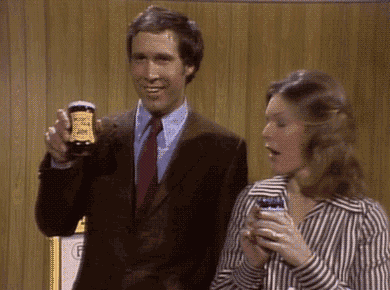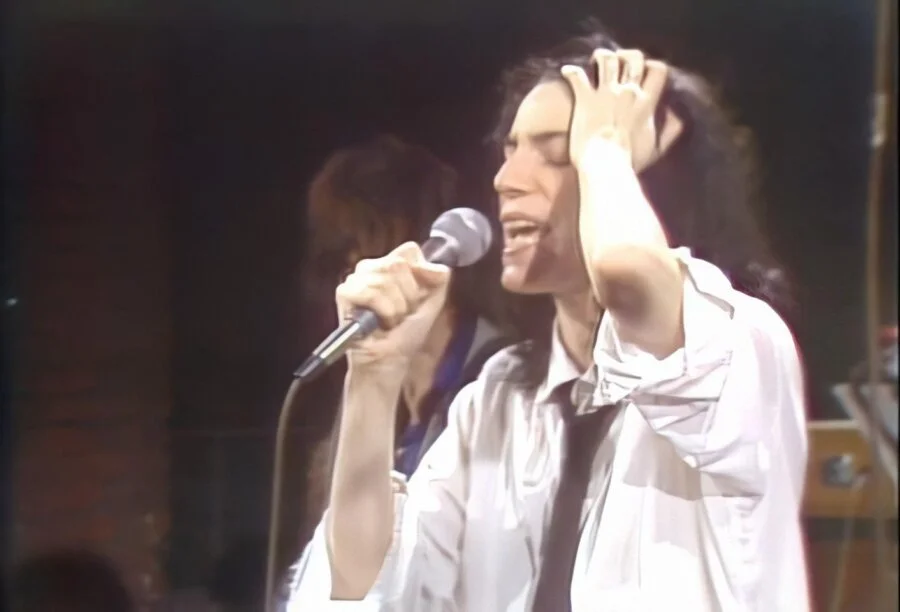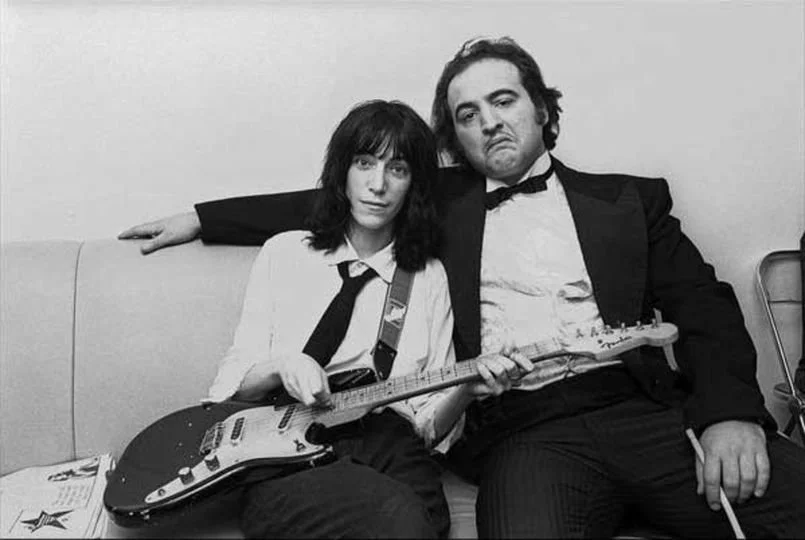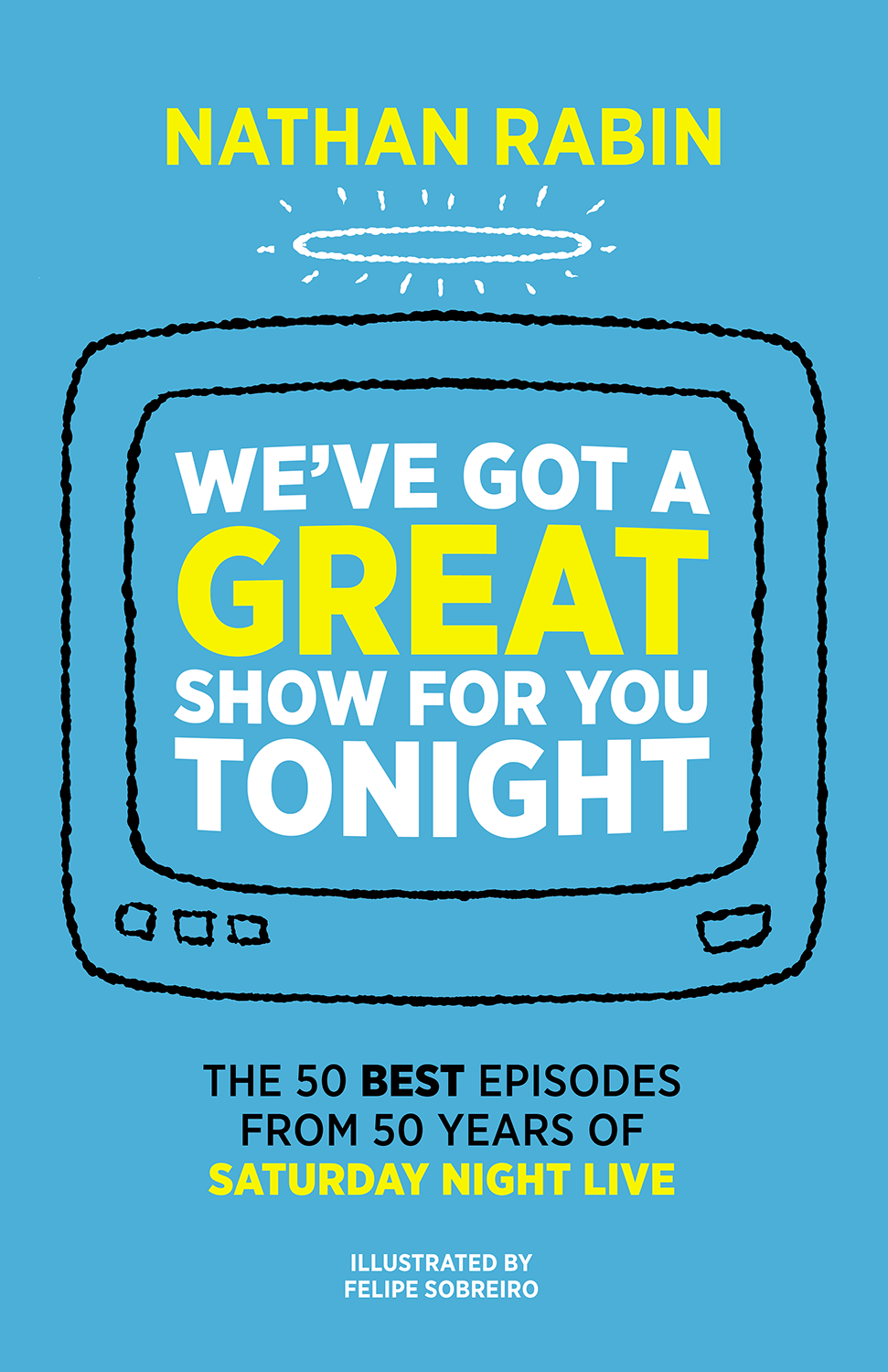Gerald Ford, Gerald Ford's Press Secretary, Patti Smith and a Precociously Schmaltzy Baby Billy Crystal United for a Saturday Night Live Episode for the Ages
They have fun!
What’s striking about Chevy Chase’s wildly popular, zeitgeist-capturing portrayal of Gerald Ford, beyond the fact that he makes no effort to look or sound like Ford, is its gentleness.
Chase iconically portrayed Ford as a genial goof who is constantly stumbling over himself physically or verbally, but who never acknowledges that he’s done anything wrong, let alone that, in Chase’s portrayal at least, he does everything wrong. This has the effect of making the short-term Commander in Chief seem casually insane in a strangely likable fashion.
This stood in sharp contrast to the show’s accurate depiction of Donald Trump as a rage-poisoned madman fueled by hatred who will destroy society if given the chance. The show’s take on Ford was mild to the point of being affectionate by comparison.
Saturday Night Live’s first presidential impression posited Ford as a bit of a bumbler, all things considered, and maybe not the brightest intellect ever to occupy the White House but fundamentally amiable.
But he looks so lifelike!
It’s crazy that that was once considered a troubling portrayal with the power to cost Ford the 1976 presidential election. Yet that’s exactly how Ford’s press secretary Ron Nessen saw Chase’s take on his boss.
As Doug Hill and Jeff Weingrad write in their essential behind the scenes history Saturday Night: A Backstage History of Saturday Night Live, “Nessen, among others in the White House, considered the media’s portrayal of Ford as a bumbler one of the most serious public relations liabilities of his administration.”
Nessen set out to co-opt Saturday Night Live’s portrayal of Ford by illustrating that they, too, were in on the joke and, unlike the Nixon administration, had a sense of humor about itself and its foibles.
The press secretary had previously worked as a news correspondent for NBC so he undoubtedly considered himself press-savvy. “Press” was even in his job title. Nessen made his living talking into a microphone in front of television cameras. So when junior writer and future Minnesota Senator Al Franken asked him if he’d host the show Nessen leaped at the chance.
Nessen’s conviction that appearing on perhaps the raunchiest show on television would help Ford politically was strengthened by a White House Correspondent Dinner where Chase gently ribbed the president, who proved a good sport.
Ford was such a good sport, in fact, that he agreed to tape three lines that would then be included in the broadcast. Ford would very stiffly deliver the magical words “Live from New York, it’s Saturday Night.” He’d also introduce Nessen as his press secretary and finally recite, “I’m Gerald Ford and you’re not” during “Weekend Update.”
Nessen would provide access to our nation’s ultimate source of power. Nessen could get the President of the United States and the most powerful man in the world, to appear on a ribald live late-night sketch comedy show.
Chevy Chase asks Ron Nessen if he’s ever thought about how weird it is that we have hands instead of claws or flippers.
In return Nessen hoped that Saturday Night Live might go a little easier on Ford and his administration. The hip television sensation and the square politician wouldn’t be friends, necessarily, but Nessen hoped that they could, at the very least, be friendly.
Proximity to power has a way of corrupting people and institutions. We have a tendency to go easy on people we know personally and have a good relationship with. We’re confronted with their messy humanity and show them empathy and consideration. At least that’s the idea.
Before he dove into the deep end by agreeing to be the host of Saturday Night Live’s seventeenth episode Nessen sought an assurance from Michaels that he would not come off as a buffoon. “When we first talked about this I told them that I can’t do anything truly embarrassing or in bad taste to the White House. And they agreed there’d be nothing like that on the show” Nessen told The Washington Post.
Ron Nessen explains comedy to the cast and crew of Saturday Night Live.
The evening would represent a fascinating war of wills between a man who represented the establishment at its stiffest and most powerful and rebellious, countercultural kids who had changed television in a mere matter of months.
Despite what Nessen had been assured, his episode of Saturday Night Live would be embarrassing for Nessen and the White House and defined by its deliberate offensiveness.
The episode begin with a cold open involving the Dead String Quartet, a bit involving four classical music playing corpses that is the epitome of taste compared to what’s to come.
Then come videos of Gerald Ford robotically delivering, “Live from New York” and “Ladies and Gentleman, the Press Secretary to the President of the United States” with a glazed expression. I’m pretty sure he was baked.
Then Nessen walks anxiously onstage in a conservative suit, looking like the nerdy Class president the stoners are pretending to befriend as a cruel, Carrie-style joke, which is not a bad description of his appearance on SNL.
Then Nessen launches anxiously into the monologue. His delivery is wavering and uncertain. He repeatedly stammers “uh” in a way that feels distractingly unprofessional.
“I guess some of you are wondering why the press secretary of the President of the United States is acting as the host of a live late night comedy show. Well, actually this is not very different from my daily press briefing at the White House.” Nessen begins nervously. Despite his words, it would appear that this job and his day job are not just different but antithetical. Nessen was the mouthpiece of the ultimate establishment figure. Saturday Night Live was television’s most anti-establishment show.
Nessen continues, drily, “A lot of people probably don’t understand exactly what a press secretary does. It’s my job to take complicated, high level events and take the jargon of politics and simplify it and tell it to the press, who then pass it on to the public.”
That’s less a joke than a fairly technical description of his profession. The politician travels a very long way for little payoff.
The punchlines finally arrive when he quips, “To learn my job effectively I’ve learned a few phrases that make this job easier, phrases like “What the president really said was…”, or, “what the president meant was”, or “What the president really bumped into was…” or, “What the president mispronounced was…”
Nessen gets a few tepid titters at the expense of the president’s clumsiness and propensity for Spoonerisms. The monologue ends with Nessen taking a call from the President saying that he’d had the monologue explained to him and he was fired.
In reality, Nessen’s appearance on Saturday Night Live would not get him fired but it seemed like the kind of thing that was not brought up much, if at all, at the Ford administration or seen as any kind of victory.
Nessen probably felt fairly confident after the monologue. It was the most stressful part of hosting and he’d done okay. He hadn’t killed or humiliated himself but he hadn’t distinguished himself either.
For the audience the best was to come. For Nessen, it would only get worse.
This was followed by a fake ad for for Super Bass-O-Matic 76, a Popeil-style miracle device that takes all the work and hassle out of fish preparation. It’s a simple blender with a cynical bicentennial red, white and blue color scheme designed to make a mush of fish and apparently only fish.
It’s a Dan Aykroyd special: the machine gun pitch of a sleazy huckster delivered at a furious pace with surgical precision.
Next comes the inevitable White House sketch with Nessen, as himself, asking his boss for permission to host Saturday Night Live.
“Sometimes they poke a little fun at you on the show. It’s all in good fun, and I think it would be a good idea to show that you can take a joke” Nessen tells Chase’s Ford. He compares it to Richard Nixon saying “Sock it to me?” on Laugh-In.
Chase’s Ford then says of Nixon and the one time he uttered something ostensibly comic in public, “By golly, (Nixon) was funny then and he’s funny now. He’s a funny man, funny man. That’s why I gave him a break.”
Chase plays Ford as a madman lost in his own world who never does anything or gets anything right but never seems to even notice. He plays the Commander in Chief as quietly crazed and disconnected from the world around him.
This extends to treating his dead stuffed dog like it’d be up for a game of fetch at any moment. He does not seem to know where or who he is, nor does he seem particularly concerned.
Chase stumbles around the Oval Office in a delirious symphony of slapstick. He mentions that his dog Liberty is pregnant and that they’re launching an investigation into it.
“You don’t have anything to do with this, Ron do you?” Ford asks his press secretary of his dog’s unplanned pregnancy.
“She’s not my type at all” Nessen responds, though he does not specify whether she’s not his type because she’s not his preferred breed or because he’s not sexually attracted to dogs.
This is a mild joke about bestiality but it is a bestiality joke all the same. It really feels as if the writers are trying to sneak as much bad taste, transgression and vulgarity onto the show as possible to embarrass the host.
Bad taste is the order of the day in a fake commercial parody of Smucker’s “With a name like Smucker’s it’s got to be good” ad campaign that proposes even more stomach-churning names like Nose Hair, Death Camp, Dog Vomit, Monkey Puss, Painful Rectal Itch, Mangled Baby Ducks, 10,000 Nuns and Orphans, All Eaten by Rats and finally a mystery jam with a name so disgusting that you can’t say it on television.
I’m guessing that the Ford administration did not want to be associated with phrases like “Mangled Baby Ducks,” “Painful Rectal Itch”, “Death Camp” and “10,000 Nuns and Orphans, All Eaten by Rats.”
Then comes something even more transgressive: musical guest Patti Smith Group. The icon’s performance begins, “Jesus died for somebody’s sins but not mine” and only grows more ferocious and feral.
It’s the punkest thing that had ever happened on Saturday Night Live. It might still be the punkest thing that’s ever happened on Saturday Night Live, particularly given the context and the fact that the broadcast would dip into Easter Sunday, which is apparently a big deal for gentiles.
Nessen returns in a segment called Press Secretaries Through History to Inform the Russian Press, “Catherine the Great has been killed in a riding accident. We really don’t have any other details except that she died in the saddle and from now on will be referred to as Catherine the Mashed.”
If you’re counting, it’s the show’s second bestiality joke in under thirty minutes.
That Ron Nessen might have seemed milquetoast but that dude had a filthy mind.
There are no bestiality gags in a sketch where John Belushi plays the face of the “New Army”, just wall to wall drug references.
The recruiter’s desk is filled with pills and potions and joints and powders and other illicit substances that he sweeps away dramatically while stealing a drag on a joint.
The stoner says of the new Army, “it’s an all volunteer Army. I mean… you don’t have to be there, if you don’t want to. I mean, if you don’t want to… that’s cool. Uh, you have your own life to lead… you have stuff to do. But so do we. The BEST stuff an Army helicopter can carry in from all over the world!”
In case you do not get his hint, by “stuff” he means “drugs.”
The pitch ends with an unexpectedly lyrical, “join today’s Army. Because… every burst of gunfire has all the colors in the rainbow.”
The show then reruns one of its most savagely satirical fake commercials in “Up Against the Wallpaper”, wall paper filled with revolutionary sentiments advertised by hippie icon Jerry Rubin.
The commercial gets an additional kick from knowing that Rubin would embrace capitalism with the same zeal as the counterculture as a businessman and stockbroker in the late 1970s and 1980s.
Even Gilda Radner’s perpetually confused old lady news commentator Emile Littela works blue with an editorial about the 1976 “Presidential erections.”
Radner returns as a woman of distinction who talks loftily of her charmed life and taste for the finer things before holding up a large bottle of what she cheerfully describes as “Autumn Fizz: The Carbonated Douche.”
It’s lewd, rude and crude, a glob of spit in the face of propriety at once scatological and satirical.
This is perhaps the only instance in history where writing and performing a sketch about carbonated douches available in a wide array of flavors might qualify as a blow against “the Man” and not just vulgarity for vulgarity’s sake.
Dan Aykroyd debuted one of his most popular and dead-on impressions in talk show host Tom Snyder. Aykroyd nails both the details and the essence of the excitable television personality, his rampaging rhythms, nervous intensity and propensity for wild digressions.
He’d end up playing Snyder over ten more times but he got him exactly right the first time around.
Then Nessen gets back to the ribaldry when he announces, as Oedipus’ press secretary, that from here on out the Queen Mother will be known as the Queen Wife. It’s not one of Nessen’s beloved bestiality gags but it is not in good taste or something that reflects well upon Gerald Ford or his administration.
The bad taste continues in a sketch where a couple in bed played by Chevy Chase and Jane Curtin are suddenly confronted by the Supreme Court, who take it upon themselves to tell the pair what kind of sex they can and can not have.
It plays tamer than it sounds but it is a sketch about a large group of men watching people have sex and issuing various opinions on it all the same.
Nessen introduces a fresh-faced, boyishly handsome comedian he calls “Bill Crystal” but who would rise to great heights as Billy Crystal.
The original iteration of The Blues Brothers.
It’s Saturday Night Live lore that Crystal was bumped from the debut for time. It’s less well known that he got his shot in an episode only slightly less auspicious than the first episode.
Crystal begins with a drug joke about how it’s tough opening for rock acts because if the fans don’t know you’ll be performing and they time their drug trips for the headliner’s entrance then they’ll have the worst trip of their lives watching Crystal do a well-intentioned but mildly offensive impersonation of “Blind” Willie Dixon for twenty interminable minutes.
Having accommodated the freaks by mentioning their beloved “drugs” Crystal launches into a monologue that is pure schmaltz, with a side of minstrelsy, sentimentality and a whole lot of corn.
In it, he talks about how he befriended lots of great artists as a boy because his father was a bigwig at seminal jazz label Commodore Records and a lot of his artists took to the eager young boy and called him “Face”, which is cool jazz lingo for a cute kid or beautiful woman.
The lights turn low and a lonely saxophone blares a melancholy melody while Crystal imitates an old black jazz musician overjoyed to encounter his close personal friend Billy Crystal and how excited he is for Billy Crystal’s success as a stand-up comedian who makes regular appearances on television.
Then he talks about his life in a crude burlesque of old school bohemian black cool. He raspily jibber jabbers about losing his choppers and having to pawn his horn so he couldn’t blow.
Crystal wasn’t going to wait to become a Saturday Night Live cast-member to recycle a catchphrase. The future Forget Paris star says, “Can you dig it? I knew that you could!” no less than SIX TIMES in a matter of minutes.
You could argue that there is a musicality to this repetition, that it’s a chorus he keeps coming back to but it feels incredibly cheap and pandering.
I have no doubt that Billy Crystal loves black people. He undoubtedly sees himself as a good friend and ally to the black community. It is precisely this familiarity that leads him to think that he can take liberties with race that he probably shouldn’t, like making a saccharine impersonation of a sassy old black musician a cornerstone of his act for decades. Then there are the liberties that Crystal DEFINITELY should not have taken, like doing blackface on Saturday Night Live as Sammy Davis Jr.
Even that, I suspect, was well-intentioned. I’m sure Crystal thought he was paying tribute to a performer he admired, not perpetuating a shameful tradition rooted in anti-black racism.
What’s crazy to me is that Crystal was still a kid when he made his first appearance on Saturday Night Live. He was still in his twenties yet he performed an antiquated routine exclusively designed to warm the hearts of old Jewish men.
It’s crazy to think that Michaels thought Crystal’s Kosher cornball comedy-drama belonged on what was then probably the hippest show on television. Crystal’s performance is reasonably well-received. There isn’t explosive laughter but it is, god help us, a character piece going for pathos as much as comedy.
It’s even crazier to think that this square kid would some day return and become one of the most popular cast-members during one of its most popular eras.
Can you dig that? I knew that you could!
The least punk segment in SNL history then leads once again to the punkest when the Patti Smith Group tears through an incendiary cover of The Who’s “My Generation” that damn near sets the stage ablaze in its righteous fury.
Nessen ends the episode by talking about what a great time he had and how much he loved working with “nifty” cast but soon the temporarily friendly relationship between the Ford administration would turn ice-cold.
Chase opens the next week’s “Weekend Update” by bragging, “Our top story tonight: Gerald Ford has been criticized all week by Conservative supporters for his appearance on, and endorsement of, a late night comedy TV show which specializes in bad taste, cheap shot humor and filthy language wherever possible. Replying to allegations that the program made the president look stupid Mr. Ford reportedly said, “Nonsense. Pass the soup onto my face, please.”
Saturday Night Live wasn’t about to let history renders its own verdict. The show took an at least partially earned victory lap just seven days later for succeeding in making their host look bad.
The show would go on to have a complicated, contradictory relationship with power, particularly as Lorne Michaels grew to become one of the most powerful figures not just in comedy but in all of entertainment.
There is a Jason Reitman movie in the works about the taping of the first episode of Saturday Night Live but I think a comedy-drama documenting the taping of this episode would be just as fascinating and rich, if not more so.
Failure, Fiasco or Secret Success: Secret Success
Check out the Indiegogo campaign for the above books here
Subscribe to the EveryEpisodeEver newsletter here
Did you enjoy this article? Then consider becoming a patron here
AND you can buy my books, signed, from me, at the site’s shop here






















